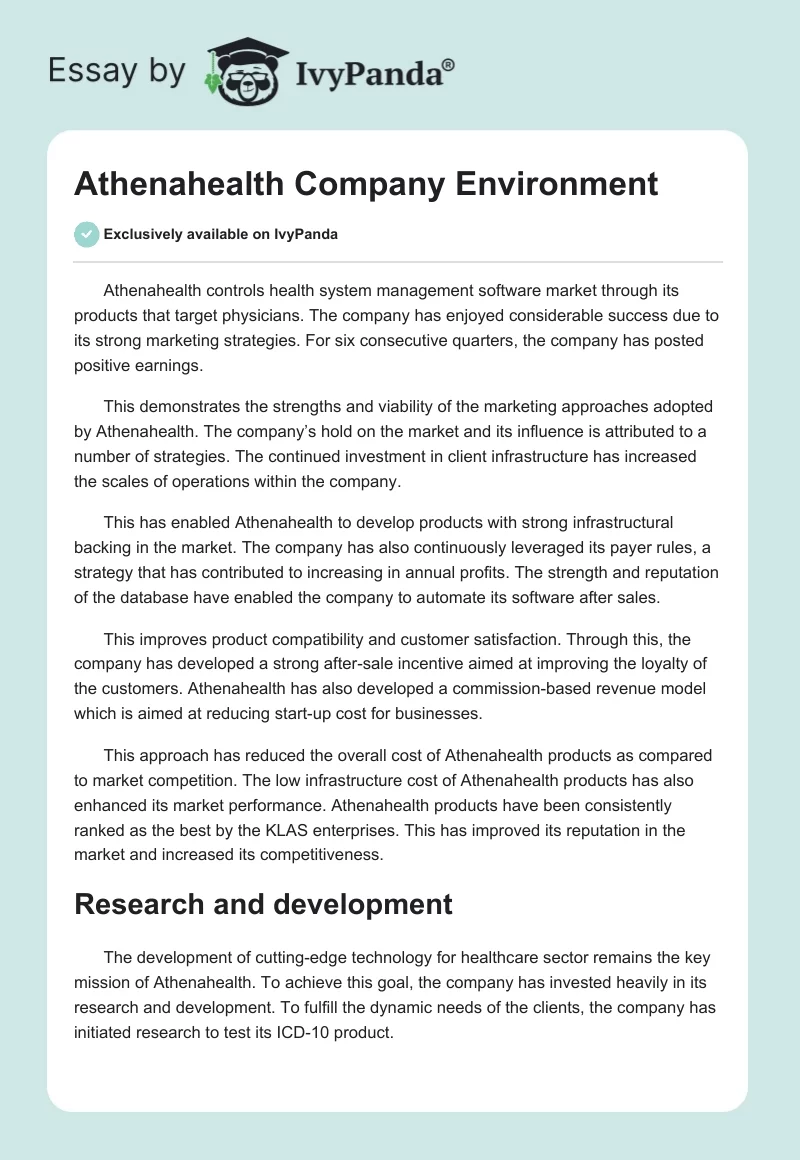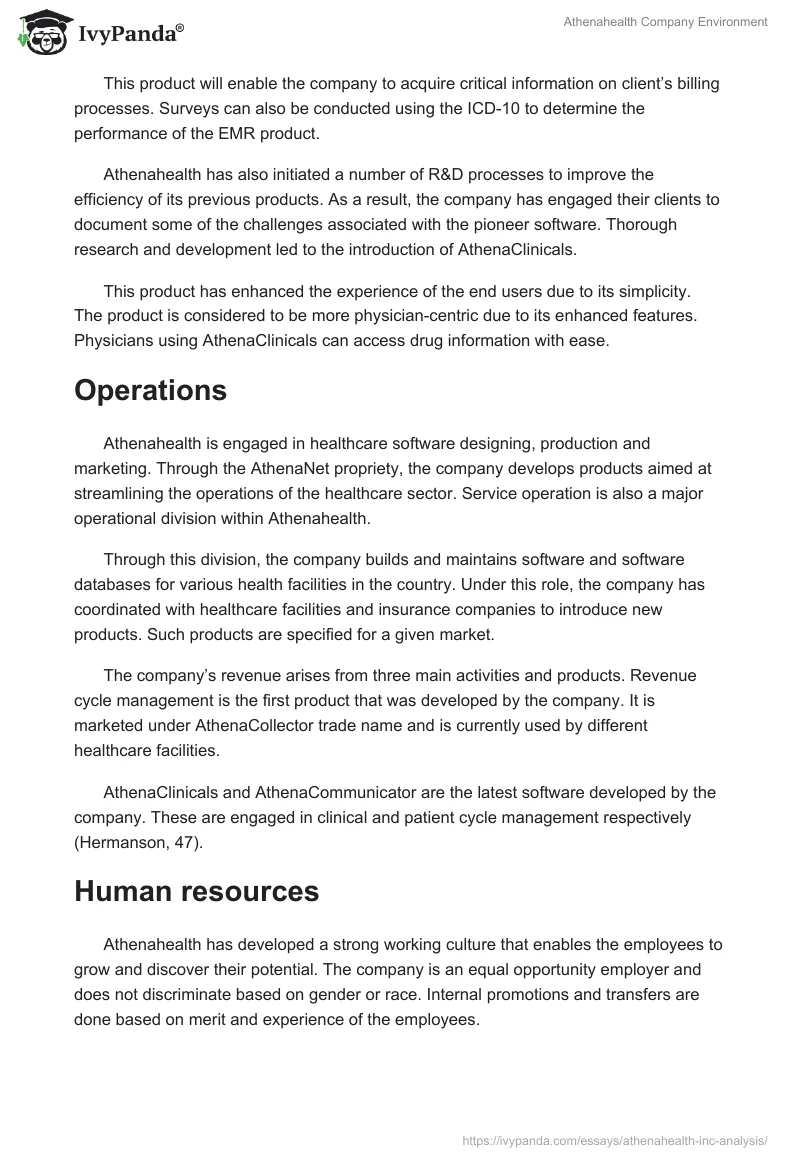Background
Athenahealth controls health system management software market through its products that target physicians. The company has enjoyed considerable success due to its strong marketing strategies. For six consecutive quarters, the company has posted positive earnings. This demonstrates the strengths and viability of the marketing approaches adopted by Athenahealth. The company’s hold on the market and its influence is attributed to a number of strategies.
The continued investment in client infrastructure has increased the scales of operations within the company. This has enabled Athenahealth to develop products with strong infrastructural backing in the market. The company has also continuously leveraged its payer rules, a strategy that has contributed to increasing in annual profits. The strength and reputation of the database have enabled the company to automate its software after sales. This improves product compatibility and customer satisfaction. Through this, the company has developed a strong after-sale incentive aimed at improving the loyalty of the customers.
Athenahealth has also developed a commission-based revenue model which is aimed at reducing start-up cost for businesses. This approach has reduced the overall cost of Athenahealth products as compared to market competition. The low infrastructure cost of Athenahealth products has also enhanced its market performance. Athenahealth products have been consistently ranked as the best by the KLAS enterprises. This has improved its reputation in the market and increased its competitiveness.
Research and development
The development of cutting-edge technology for healthcare sector remains the key mission of Athenahealth. To achieve this goal, the company has invested heavily in its research and development. To fulfill the dynamic needs of the clients, the company has initiated research to test its ICD-10 product. This product will enable the company to acquire critical information on client’s billing processes. Surveys can also be conducted using the ICD-10 to determine the performance of the EMR product.
Athenahealth has also initiated a number of R&D processes to improve the efficiency of its previous products. As a result, the company has engaged their clients to document some of the challenges associated with the pioneer software. Thorough research and development led to the introduction of AthenaClinicals. This product has enhanced the experience of the end users due to its simplicity. The product is considered to be more physician-centric due to its enhanced features. Physicians using AthenaClinicals can access drug information with ease.
Product development
Athenahealth is engaged in healthcare software designing, production and marketing. Through the AthenaNet propriety, the company develops products aimed at streamlining the operations of the healthcare sector. Service operation is also a major operational division within Athenahealth. Through this division, the company builds and maintains software and software databases for various health facilities in the country. Under this role, the company has coordinated with healthcare facilities and insurance companies to introduce new products. Such products are specified for a given market.
The company’s revenue arises from three main activities and products. Revenue cycle management is the first product that was developed by the company. It is marketed under AthenaCollector trade name and is currently used by different healthcare facilities. AthenaClinicals and AthenaCommunicator are the latest software developed by the company. These are engaged in clinical and patient cycle management respectively (Hermanson, 47).
Human resources
Athenahealth has developed a strong working culture that enables the employees to grow and discover their potential. The company is an equal opportunity employer and does not discriminate based on gender or race. Internal promotions and transfers are done based on merit and experience of the employees.
To meet the needs of the market, employees at Athenahealth are constantly trained and exposed to new ways of product development. To address the emerging issues in the organization, the company engages in periodical employee engagement surveys (Lois and Aneil, 198).
Culture/ethics
Culture is the most valuable asset at Athenahealth according to the chief executive officer. By developing a culture that rewards high achievers and supports underperformers, the company has enhanced employee cooperation. All ‘Athenistas’, as they are famously called, are entitled to appraisal and stock awards. This enhances the professional development of the employees.
Challenges
Marketing
According to Cosinuke Rob, the Vice President of Athenahealth, the well-intended regulations introduced by the government affect the marketing strategies of the company. The government has introduced subsidies for technology such as the products developed by Athenahealth. Due to such constraint, healthcare innovation and software development has remained slow (Duncan, 53).
Research and development
The financial and human cost of research and development is high at Athenahealth. To meet the cost of developing a new product, the company must increase the cost of its products. The regulatory subsidies introduced by the government to make the products accessible to healthcare facilities affects the R&D gains made by the company (Hamilton, 281).
Product development
The healthcare software market presents a number of challenges to companies such as Athenahealth. While other software companies serve a wide market with varied tastes and preferences, the healthcare market has a unique specification. The design of products for this market is also influenced by various government policies such as subsidies which affect innovation and product development (Duncan, 53).
Finance
Despite posting impressive sales, the market capitalization of Athenahealth has remained below one billion. Recent financial reports of the company placed the market capitalization at $800 million. The share value of the company at the stock exchange has also remained low. In 2009, the company reached its high price value of 23.96 (Kuratko, 42).
Core competencies
Athenahealth has a number of core competencies which has led to its impressive performance. First, the organization is aligned to the needs of the customers and the changes in the market. A portion of Athenahealth revenue comes from the fees charged by its customers. This is a commission-based model that was adopted to reduce the installation cost incurred by customers (Marbury, 34).
Apart from developing a commissioned based sale approach, Athenahealth is renowned for its high-quality products. The company designs its products based on the challenges facing the market. As a result, the company has consistently received positive reviews from the market.
The company has been recognized for supporting the healthcare sector by the KLAS enterprises. This is a healthcare reform research firm aimed at improving the quality of healthcare services (Adler-Milstein, 347). The human resource model in the company has also improved its market performance and competitiveness. Employees at Athenahealth are constantly trained and subjected to seminars as a way of enhancing their skills. Motivation of employees is at the center of the company’s culture. As a result, employees in the company are dedicated and committed to developing high-quality products (Duncan, 53).
The healthcare system is reliant on the policies of other industries such as insurance and education. Athenahealth has remained cognizant to this by maintaining a close relationship with the different industries. For example, most of the products of the company are developed in collaboration with health insurance companies. Through this collaborative approach, the products developed by Athenahealth have been accepted in the market (Udell, 30).
Competitive advantage
Athenahealth is a pioneer in healthcare management software. This has granted the company significant control of the market as compared to competitors. Though the market lack barriers to new entrants, the performance of Athenahealth has not been affected.
Athenahealth has strong competitive advantage due to its great innovativeness and uniqueness. AthenaClinical and AthenaCollector provide market unique products. Most of these products are developed in consultation with stakeholders in the healthcare industry. This has improved the market response towards the products developed by Athenahealth (Jones and Frank, 312).
Key weaknesses
Despite the impressive performance of the company in the market, Athenahealth faces a number of challenges. First, the company’s business model exposes it to market risk. Contractual involvement model forces the company to form long-term relationships with the companies that acquire its products. This model subjects the company to policy and regulatory restrictions.
The company is also engaged in long distance service provision (Gold, 357). By leasing and operating the data hosting facilities from northern parts of the country, the company is exposed to interruptions. The long distance delays caused by internet disconnection affect the company’s clients. Backup cost for the services provided by the company also push the price of the products up. To remain on top of the market, Athenahealth must develop new strategic measures (Udell, 30).
Strategic analysis
Functional strategies
To remain on top of the market, Athenahealth must increase its production efficiency. This can be achieved through increasing research and development activities. The development of new products must not affect the profitability of the company.
Currently, the company focuses on three main products. Increasing the number of brands marketed will not affect the efficiency of the manufacturing process.
Corporate level strategy
Athenahealth has failed to adopt a viable corporate level strategy, instead focusing on the domestic market. Despite the potential of its products, Athenahealth has failed to enter new markets and diversify its products. It has only three software products targeting markets within the range of its servers. The company should shift its corporate level strategy and enter new global markets (Udell, 30).
Central problem identification
According to Jonathan Bush, the chairman of Athenahealth, quality remains the focus and culture of the company. The products developed by the company have so far met the expectation of the clients. However, challenges associated with internet connectivity and server instability affect the quality of the services offered. Athenahealth should concentrate in decentralizing its offices to other parts of the country.
A number of central problems exist that affect the success of the company. First, the share value of the company has remained static despite changes in the market. Despite control of the market, Athenahealth has failed to cover all healthcare facilities in the country.
Strategic recommendations
Healthcare information technologies are an emerging market that presents massive opportunities to Athenahealth. However, the company must adopt a number of new strategies which can enhance its market performance. The company should diversify its offices and develop new servers to increase its coverage.
This will enhance its presence in the country. The company should also change its client engagement model to reduce the risks associated with post sales services.
Works cited
Adler-Milstein, Julia and Robert Huckman. “The Impact Of Electronic Health Record Use On Physician Productivity.” American Journal of Managed Care 19.1 (2013): 345-352. Print.
Duncan, Loretta. “Managing Your Practice. AMS Partners With Athenahealth, Inc.” The Journal of the Arkansas Medical Society 103.3 (2006): 52-53. Print.
Gold, Marsha. “Evolving Vendor Market for HITECH-Certified Ambulatory EHR Products.” American Journal of Managed Care 19.1 (2013): 353-361. Print.
Hamilton, Byron. Electronic Health Records. Boston: McGraw-Hill Higher Education, 2009. Print.
Hermanson, Dana. “How Effective Are Organizations’ Internal Controls? Insights into Specific Internal Control Elements.” Current Issues In Auditing 6.1 (2012): 31-50. Print.
Jones, Stephan and Frank Groom. Information and Communication Technologies in Healthcare. Boca Raton, FL: CRC, 2012. Print.
Kuratko, Donald. “Diagnosing a Firm’s Internal Environment for Corporate Entrepreneurship.” Business Horizons 57.1 (2014): 37-47. Print.
Lois Boynton and Aneil, Mishra. “Driving Employee Engagement: The Expanded Role Of Internal Communications. “Journal of Business Communication 51.2 (2014): 183-202. Print.
Marbury, Donna. “Post-Implementation: Making the EHR System Work for You.” Medical Economics 5:2 (2014): 34.Print.
Udell, Melody. “Ten Minutes with Rob Cosinuke.” Marketing Health Services 34.3 (2014): 28-31. Print.


